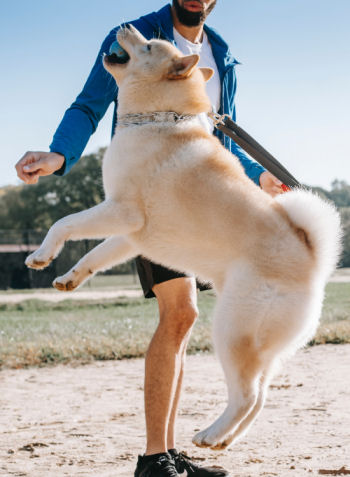It’s really cute when puppies jump up to get attention. It’s not cute anymore when the dog grows up and isn’t a cute, tiny puppy any more. So how do you stop your dog from jumping on people?
Cry for attention

Dogs don’t generally just jump for joy. When they’re so full of energy they just can’t contain themselves, jumping up and down isn’t the usual behavior. Instead, they’ll get the “zoomies” and run like crazy. If your house, like ours, has a circular path, they’ll make it into a race track. And you’d best just stay out of the way until the zoomies run out.
Jumping, especially on people, is a plea for attention. And the best way to get it to stop is by ignoring it. Which, we freely admit, is easier said than done.
In Hope’s Beginning Obedience/Puppy classes, dogs will often jump on her as she approaches. We don’t know if you can tell from our videos, but she’s not a big person. She’s about five-foot-nothing tall, and not incredibly substantial. In one session, there was a lovely, 50+ lb. Lab puppy named Gus who adored jumping on Hope and grabbing the mask off her face. On his hind legs, Gus is about the same height as Hope, so her mask was well within reach. It’s worth noting that he really is a very nice dog – he never snagged anything but the mask.
Be prepared
Knowing when your dog is likely to jump on someone, and what circumstances trigger the behavior, is key in stopping it. Set up the situation and be prepared.
In this case, Hope had Gus’s people keep hold of his leash until she braced herself and was ready for his enthusiasm. Then she told them to release enough slack for Gus to reach her, but not go past. Gus grabbed the mask again, but Hope did nothing. She didn’t move, didn’t play “tug” with the mask, didn’t look at him, didn’t pay any attention to him. She looked past Gus at his people. And had to tell them repeatedly not to react.
And, after a few seconds of acting the fool, Gus got all four feet on the ground. Immediately, Hope told him what a good boy he was and started petting him. Which triggered his jumping.
Hope instantly returned to braced-statue mode. No reaction whatsoever. And Gus got all four feet on the ground. Which earned him the praise and attention he wanted.
Instant gratification
Timing is important in teaching dogs. If the lesson is “don’t jump on people” there has to be a visible difference. Jump = no attention. No jumping = praise, treats, and attention.
We’ve often said that doing nothing is, by far, the hardest part of dog training. (“The hardest part of dog training“) If you pay attention to behaviors you don’t want, you’re encouraging that behavior. If you remove that attention, the dog has no reason to continue the behavior – it’s not working for him.
Dogs always give you more of the behavior you focus on. If you repeatedly say “off, get off, no jump” it’s paying attention to the behavior. It works much better to emphasize when your dog is doing something you want. Instant praise, treats, or a game of tug will tell your dog he’s being “good,” that you like what he’s doing, and he’ll get more attention with this good choice.
Making good choices
Everyone, dogs included, is sufficiently selfish to do what works best. If jumping on people results in attention, even if it’s “No, No, bad dog,” it’s working. Dogs don’t discriminate between negative and positive attention. To your dog, anytime you focus on them, it’s a good thing.
If you ignore the behavior you don’t want, your dog has no reason to continue doing it. The dog’s behavior isn’t working, so they stop doing it.
If your dog is jumping on someone, have them stand like a statue. Fold their arms across their chest and stare at the ceiling. It may take some repetitions, but your dog will learn that jumping gets them nothing they want. Dogs particularly hate it when you don’t look at them. So make a point of looking away.
Flip side
The other side of the coin has to be just as fast and clear. If the dog has all four feet on the ground, meet their eyes, praise them mightily, and give treats, pets, toys. For as long as the good behavior lasts. Be ready to stop in mid-word if the jumping starts.
It may take some time for the lesson to sink in. Each time the dog gets the same message, the “right” choice penetrates deeper into their personality. By the end of the class session, Gus sat whenever Hope came over to see him. Good boy, Gus!
